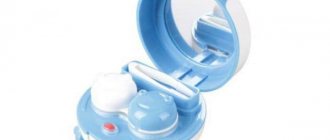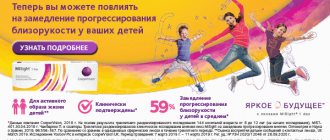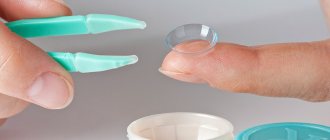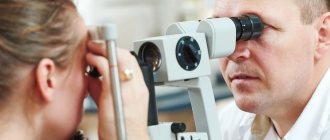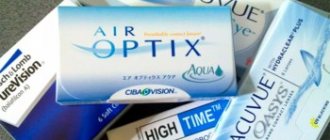Features and benefits of soft contact lenses
According to statistics, about 90% of people who use lenses prefer soft models. They have several undeniable advantages:
- they are elastic and thin;
- fit tightly to the cornea;
- suitable for correcting farsightedness, myopia and astigmatism;
- do not require adaptation, so they are suitable for those who occasionally replace glasses with lenses;
- allow oxygen to pass through;
- the material retains a lot of moisture, therefore preventing dry eyes;
- provide clarity of central and peripheral vision;
- suitable for people with increased sensitivity, as they do not cause discomfort while wearing.
Characteristics of materials for the production of contact lenses
These characteristics can vary widely depending on the material (traditional hydrogel, silicone hydrogel) [1–3]. Although this article cannot cover every aspect of contact lens design, it does summarize the basic properties of contact lens materials. In addition, we will briefly discuss how these characteristics can influence each other, as well as how different properties of contact lenses affect their clinical behavior.
1. Oxygen permeability. Oxygen permeability Dk describes the ability of oxygen to passively pass through the material of the contact lens, and the oxygen transmittance index Dk/t characterizes its ability to pass through the thickness of the contact lens [1]. The first materials from which contact lenses were made did not allow oxygen to pass through, which caused negative clinical reactions such as corneal edema [1]. Major innovations in materials development led to the creation of hydrogels (low to medium Dk) and subsequently silicone hydrogels (high Dk) [1]. Traditional hydrogel materials provide the oxygen transport needed by the open eye (lens Dk/t of approximately 24) to prevent corneal edema, while silicone hydrogels typically provide the oxygen transport needed to prevent corneal edema when the eye is closed. eye (Dk/t for the lens is approximately 87) [1]. Although Dk/t values for silicone hydrogel lenses are generally considered to be more than adequate to physiological requirements, larger values are not unnecessary, since some of the signs of a healthy cornea (for example, the absence of epithelial acidosis) are preserved at Dk/t greater than 87 [1]. The advent of contact lenses with high Dk/t made it possible to reduce corneal edema, but did not reduce the incidence of infections and did not significantly improve wearing comfort [1].
2. Modulus of elasticity. The modulus of elasticity of a contact lens is a measure of the stiffness of its material [4]. For ophthalmologists and optometrists, this indicator is important, since it has been established that lenses made of materials with a high elastic modulus can cause the development of mechanical complications, such as giant papillary conjunctivitis or superior arcuate epithelial ulcers [4]. Lenses made from materials with low moisture content usually have a high modulus of elasticity, and those made from materials with high moisture content tend to have a low modulus, although there are exceptions in both cases [4]. The elastic modulus may vary slightly with temperature [4].
3. Contact angle. This angle between the surface of the lens and the liquid drop shows a measure of wettability. The larger the contact angle, the lower the wettability of the contact lens [5]. The contact angle is determined by the material; there is no clear difference in this regard between traditional hydrogels and silicone hydrogels [6]. It is known that increasing the wettability of a contact lens leads to an improvement in the comfort of wearing it [7].
4. Dehydration (loss of moisture). Contact lenses undergo dehydration during wear, which increases in dry environments and wind [3, 8]. Dehydration of traditional hydrogel contact lenses can reduce oxygen transmission, which leads to an increased likelihood of developing hypoxic complications [3]. Silicone hydrogel lenses are less susceptible to dehydration than hydrogel lenses, but to date no clear connection has been established between lens dehydration and the comfort of wearing it [3].
5. Friction coefficient. It can be defined as “the ratio of the frictional force of two bodies to the normal force pressing these bodies against each other” [9]. The coefficient of friction of soft contact lenses varies widely (without much difference between lenses made from traditional hydrogels and silicone hydrogels, but it can increase when deposits accumulate on the surface of the lens [9]. With a high coefficient of friction, the comfort of wearing lenses decreases [9].
6. Deposits on contact lenses. They can occur as a result of environmental influences (for example, due to the application of makeup) or the tear film [2, 10]. The most well studied are protein and lipid deposits [2]. In general, studies have shown that traditional hydrogel lenses have high levels of protein deposits and low levels of lipid deposits; the opposite trend was found when studying silicone hydrogel lenses [2]. Again, there are exceptions here [11]. Deposits can lead to decreased comfort in wearing lenses, deterioration in the quality of visual perception, and diseases such as giant papillary conjunctivitis [2, 7, 12]. Therefore, before re-inserting contact lenses, it is necessary to thoroughly clean them using a care system, which involves mechanically cleaning the lenses before rinsing (rub and rinse) [13–15].
Contact lenses on the market have been designed to create synergy with the surface of the eye when worn, ensuring regular and healthy use. To do this, the developers had to take into account all the characteristics described above. Moreover, the need to improve biocompatibility and wearing comfort has led to the fact that we have a huge selection of brands of contact lenses. At first glance, such a large number of similar soft lenses may seem unnecessary. However, small changes in the presented characteristics of the materials can lead to important changes in the success of their wear by our patients. This is something to keep in mind when a patient comes into our office who has a more difficult time fitting contact lenses than others. Therefore, there will always be a demand in the market for contact lenses with different characteristics of their materials.
Bibliography
- Papas EB. The significance of oxygen during contact lens wear. Cont Lens Anterior Eye 2014; 37:394–404.
- Nichols JJ. Deposition on silicone hydrogel lenses. Eye Contact Lens 2013; 39:20–23.
- Dillehay SM. Does the level of available oxygen impact comfort in contact lens wear?: A review of the literature. Eye Contact Lens 2007; 33: 148–55.
- Horst CR, Brodland B, Jones LW, et al. Measuring the modulus of silicone hydrogel contact lenses. Optom Vis Sci 2012; 89:1468–76.
- Campbell D, Carnell SM, Eden RJ. Applicability of contact angle techniques used in the analysis of contact lenses, part 1: comparative methodologies. Eye Contact Lens 2013; 39: 254–62.
- Lira M, Silva R. Effect of lens care systems on silicone hydrogel contact lens hydrophobicity. Eye Contact Lens 2016; Epub ahead of print.
- Truong TN, Graham AD, Lin MC. Factors in contact lens symptoms: evidence from a multistudy database. Optom Vis Sci 2014; 91: 133–41.
- Martin-Montanez V, Lopez-Miguel A, Arroyo C, et al. Influence of environmental factors in the in vitro dehydration of hydrogel and silicone hydrogel contact lenses. J Biomed Mater Res B Appl Biomater 2014; 102:764–71.
- Sterner O, Aeschlimann R, Zurcher S, et al. Friction measurements on contact lenses in a physiologically relevant environment: effect of testing conditions on friction. Invest Ophthalmol Vis Sci 2016; 57:5383–92.
- Ng A, Evans K, North RV, et al. Impact of eye cosmetics on the eye, adnexa, and ocular surface. Eye Contact Lens 2016; 42: 211–20.
- Pucker AD, Thangavelu M, Nichols JJ. In vitro lipid deposition on hydrogel and silicone hydrogel contact lenses. Invest Ophthalmol Vis Sci 2010; 51:6334–40.
- Allansmith MR, Korb DR, Greiner JV, et al. Giant papillary conjunctivitis in contact lens wearers. Am J Ophthalmol 1977; 83:697–708.
- Pucker AD, Nichols JJ. Impact of a rinse step on protein removal from silicone hydrogel contact lenses. Optom Vis Sci 2009; 86:943–7.
- Cho P, Cheng SY, Chan WY, et al. Soft contact lens cleaning: rub or no-rub? Ophthalmic Physiol Opt 2009; 29:49–57.
- Tam NK, Pitt WG, Perez KX, et al. Prevention and removal of lipid deposits by lens care solutions and rubbing. Optom Vis Sci 2014; 91:1430–9.
Author: Andrew Pucker, Senior Lecturer, Department of Optometry and Vision Science, University of Alabama (Birmingham, USA)
Translation © RA “Veko”
The printed version of the article was published in the journal “Modern Optometry” [2020. No. 8 (137)].
For questions about purchasing magazines and subscribing, please contact the sales department of the RA Veko:
- Tel..
- www.veko.ru
Our pages on social networks:
- vk.com/vekomagazine
- fb.com/vekomagazine
Materials I use to make SCLs
Soft contact lenses are made from hydrogel or silicone hydrogel. Hydrogel ones have low oxygen permeability, so they need to be removed at night. But this material retains moisture well. People who wear soft contact lenses do not experience discomfort or dry eyes.
A more modern material is silicone hydrogel. It allows oxygen to pass through better, so the lenses can be worn for a long time and left overnight. The disadvantage of the material is the possibility of allergic reactions and fragility.
Hydrogel lenses
Hydrogel contact lenses are a combination of gel, which does not allow oxygen to pass through at all, and water, which allows oxygen to pass through to the cornea in such lenses. Therefore, in hydrogel lenses, the higher the moisture content, the higher the oxygen permeability. There is a direct relationship between moisture content and oxygen permeability in hydrogel contact lenses.
Hydrogel contact lenses with high moisture content:
- – Biotrue 1-Day is the wettest hydrogel lens with the highest moisture content of 78% and has an oxygen transmittance Dk/t of 42.
- — Dailies AquaComfort Plus moisture content is 69% while oxygen permeability is 26.
- – Proclear 1Day contain 60% water and have an oxygen permeability of 28.
- – Proclear monthly wear has a water content of 62% and an oxygen permeability index of 42.
- – Biomedics XC contain 60% water and have a Dk/t value of 33. All these hydrogel lenses, precisely due to their high moisture content, which provides relatively high oxygen transmission, are considered the safest among hydrogel lenses.
Wearing comfort
Another advantage of high moisture content is increased comfort when wearing lenses. There is a direct connection between high moisture levels and lens comfort. But there is a small nuance - in order to maintain the level of comfort in hydrogel lenses, and therefore the level of oxygen transmission throughout the day, the lenses must not only have a high moisture content, but also retain moisture well, preventing it from evaporating - these are the hydrogel lenses those with high moisture content and the ability to retain moisture will be the most comfortable and safe.
What to look for when choosing
When choosing soft contact lenses, you need to pay attention to several characteristics:
- Replacement frequency. Soft contact lenses can be daily use or routine replacement. The first option does not require maintenance, is easy to use, safe for the eyes, but is more expensive. When using scheduled replacement lenses, you must clean them daily and place them in a special solution.
- Breathability is important for maintaining corneal health. If she does not receive enough oxygen, her vision will deteriorate. The risk of various pathologies increases.
- Moisture content can range from 38% to 80%. But you also need to take into account the ability of the material to retain moisture. Comfort and lack of irritation while wearing will depend on this.
- It is better to choose soft contact lenses produced by well-known companies: Acuvue, Bausch & Lomb, Alcon, Maxima, OKVision, Ophthalmix.
Elastic modulus
A characteristic such as elastic modulus or “stiffness” is an indicator that has not even been considered for hydrogel lenses.
It is important for silicone hydrogel lenses, since the addition of silicone often leads to a decrease in the moisture content in the lens; The combination and balance of these factors results in silicone hydrogel lenses typically having a higher modulus of elasticity than hydrogel materials. The modulus of elasticity is a measure of the possible deformation and change in shape under the influence of pressure. Elastic modulus or Young's modulus (E) is described as the ability of a lens material to conform to the shape of the ocular surface and remain resistant to deformation under pressure.
E = stress/strain
Of course, elastic modulus has clinical relevance. Lenses with an elastic modulus that are too low are more difficult for the patient to handle and do not move enough during blinking, which interferes with tear exchange. However, too high an elastic modulus can lead to mechanical ocular tissue disorders such as superior arcuate corneal epithelial injury and contact lens-associated papillary conjunctivitis.
Mechanical damage associated with the high elastic modulus of silicone hydrogel lenses: superior arcuate epithelial injury of the cornea (SEAL) and contact lens-induced papillary conjunctivitis (CLIPC).
Follow this link to learn how this feature affects comfort.
To display this page, Flash Player 9 or later must be installed and JavaScript must be enabled. Click here to download Flash Player.
Loading the player...
Dr. Lenora Copper explains the method for determining elastic modulus
Rating of soft contact lenses: TOP 10
Reviews from patients and recommendations from ophthalmologists helped determine the 10 best options for soft contact lenses.
Click to enlarge
Acuvue 1 Day Moist
Premium quality daily soft contact lenses. Provide 100% hydration throughout the entire wearing period. It contains a component similar to natural tears.
A special soft hydrogel blocks up to 70% of ultraviolet rays. Light tint makes it easy to use. A new pair every day ensures there are no allergic reactions and eliminates the need for cleaning.
The moisture content is only 58%, so it is not recommended to wear soft contact lenses for more than 10 hours. Optical power range from +6 to -12. These lenses are suitable for people with astigmatism and increased sensitivity. Can be worn when working at a computer, in a heated or air-conditioned room. Provide comfort due to thin flexible material that allows oxygen to pass through.
Advantages:
- suitable for people with allergies;
- there are UV filters;
- do not interfere or cause discomfort;
- high hydration;
- fit tightly, do not move with active movement of the eyeball.
Flaws:
- It may be difficult to put on and take off;
- fragile.
Bausch & Lomb PureVision
Soft contact lenses are produced using the latest technology, which allows you to wear them without removing them for a month. Thanks to their special shape and high oxygen permeability, they do not cause discomfort.
The combination of silicone and hydrogel ensures a natural supply of oxygen. The special coating increases resistance to protein deposits. Contact lenses are thin and smooth, do not feel when worn, do not move, do not dry out or rub.
Advantages:
- high level of oxygen permeability;
- affordable price;
- flexible wearing mode;
- two radii of curvature.
Flaws:
- for positive diopters, curvature is only 8.3;
- low moisture content.
Dailies (Alcon) Total1
Daily soft contact lenses are created using the latest technology from water-gradient material. The moisturizing coating ensures wearing comfort and retains moisture all day. Therefore, sensations of dryness or burning are excluded. The optics are completely adjacent to the cornea and do not interfere.
The soft, smooth hydrogel prevents redness and irritation. Dailis contact lenses have a high oxygen permeability of 156 units. Worn during the day, for 12-14 hours. Suitable for beginners, as well as people with hypersensitivity and dry eye syndrome.
Optical power from +6 to -12. Provide 100% visual acuity. Can be used for working on a computer.
Advantages:
- allow air to pass through;
- hydration 80%;
- do not create discomfort when worn for 16 hours;
- easy to put on;
- so smooth that you cannot feel it when blinking;
- suitable for people with allergies;
- No cleaning solution, containers, or moisturizing drops are needed.
Flaws:
- curvature 8.5;
- difficult to shoot;
- delicate surface, sensitive to damage;
- no UV filters;
- high price.
Maxima 55 UV
Designed for daytime wear. Suitable for people with a slight degree of astigmatism. Several radii of curvature allow you to choose the appropriate option. A slight blue tint does not interfere and provides protection from UV rays. Contact lenses can be worn even on a sunny day. Optical power from +8 to -10.
Soft hydrogel and 55% moisture level ensure wearing comfort. The eyes do not turn red, do not get tired, the optics do not shift, and do not interfere. Provides 100% vision correction. Thanks to the aspherical surface, it forms a clear and contrasting picture and neutralizes distortion.
Advantages:
- soft thin material, does not tear;
- suitable for beginners;
- high oxygen permeability;
- can be used by people with myopia, farsightedness and astigmatism;
- there is UV protection;
- affordable price.
Flaws:
- difficult to put on;
- you need to purchase a solution and clean the surface.
Ophthalmix Profi
Silicone hydrogel thin long-wear contact lenses. They are almost invisible on the eyes and allow oxygen to pass through, so you can leave them on for a week. Ophthalmix has UV protection. Take the shape of the cornea. A special coating protects the surface from protein deposits.
Wearing does not cause irritation, redness, or burning. The optics do not interfere with blinking. Thanks to the moisturizing additive, it prevents the appearance of dry eye syndrome and is not felt on the eye. The aspherical surface ensures clear images.
Advantages:
- thin and smooth, do not interfere;
- UV protection;
- high level of oxygen permeability;
- can be left on the eyeball overnight.
Flaws:
- when worn for a long time, additional moisturizing is required;
- fragile, easily damaged when removed;
- may cause slight discomfort at night.
Acuvue Oasys 1-Day with HydraLuxe
Soft silicone hydrogel contact lenses created using HydraLuxe technology. It provides high comfort and helps avoid dryness and eye fatigue. The coating on both sides of the lens is close in composition to natural tears. Thanks to this, the eye cornea remains moisturized throughout the day.
The smooth surface prevents friction and irritation. Suitable for allergy sufferers.
Diopter range – from +8 to -12. There are two radii of curvature. The high level of oxygen permeability ensures wearing comfort for 12 hours. Block ultraviolet rays and are invisible to the eyes.
Advantages:
- suitable for hypersensitivity;
- do not move, do not interfere;
- prevent dryness;
- There are UV filters.
Flaws:
- difficult to remove;
- high price.
OKVision Season
These are unique soft and ultra-thin lenses that can be replaced after 3 months. The optical power range is from +12.5 to -15 diopters. They have increased resistance to moisture loss. Prevents eye dryness and is comfortable to wear. Small thickness ensures high oxygen permeability. The special coating prevents the accumulation of protein deposits.
Advantages:
- large range of optical power;
- long-term wearing;
- provide 100% correction of focal and peripheral vision;
- UV filter;
- durable;
- low cost.
Flaws:
- one radius of curvature;
- plus ones cost more.
Acuvue 1 Day TruEye
Daily lenses are made of thin silicone hydrogel with a high level of breathability - more than 100 Dk/t. Thanks to Hydraclear technology, the surface is smooth, which eliminates friction and irritation while wearing. They are not felt at all. Provide 100% clarity of vision.
Soft contact lenses are comfortable to wear for 16 hours, soft and breathable. Protects eyes from ultraviolet radiation and irritation, reduces photophobia.
Advantages:
- good hydration;
- high UV protection;
- no solution or containers required;
- suitable for allergy sufferers.
Disadvantages - high cost.
Ophthalmix One Day
Soft daily disposable contact lenses made of silicone hydrogel, biocompatible with the ocular mucosa. Due to high permeability, they prevent corneal hypoxia. Created using special Advanced Edge technology, which provides increased surface smoothness.
The smooth edges of the optics prevent friction and eye irritation. Therefore, the lenses are comfortable to wear and do not cause a foreign body sensation, burning or itching. The aspherical design eliminates aberrations, so the picture is clear and free of distortion.
Advantages:
- fit well to the cornea and do not move;
- allow oxygen to pass through;
- high level of moisture throughout the day;
- suitable for sensitive eyes;
- increased resistance to protein deposits;
- UV protection.
Disadvantages - only one radius of curvature.
Brands of silicone hydrogel contact lenses
According to the period of wearing and replacement, silicone hydrogel contact lenses come in the following brands:
Brands of daily silicone hydrogel lenses
- one-day wearing period – Acuvue TruEye, Acuvue Oasys 1 Day with Hydraluxe, Dailies Total 1
Brands of two-week silicone hydrogel lenses
- two-week wearing period – Acuvue Oasys, Acuvue Oasys for Astigmatism
Brands of monthly silicone hydrogel lenses
- monthly wearing period – Pure Vision, Pure Vision 2 HD, Air Optix Aqua, Air Optix Multifocal, Air Optix for Astigmatism, Air Optix Plus HudraGlade, Air Optix Night Day, Adria O2O2, Biofinity, Biofinity XR, Biofinity Toric, Biofinity Multifocal, Clariti Elite
Silicone hydrogel lenses are not produced for a wear period of more than a month.


